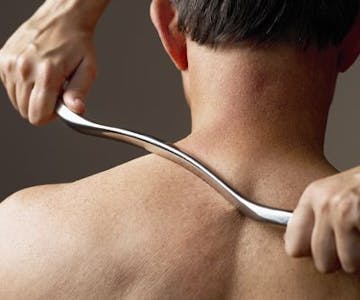
Graston Technique® effectively detects and breaks down scar tissue, adhesions and other restrictions in muscles, tendons and ligaments as well as reducing inflammation that causes pain and restricted mobility. Physical and occupational therapist, hand therapists, chiropractors and athletic trainers use the stainless steel instruments to comb over and "catch" on fibrotic tissue, which immediately identifies areas of restriction. Once the tissue dysfunction has been identified, the instruments break up the scar tissue, so the body can absorb it.
Clinicians use Graston Technique to treat soft tissue (fascia) dysfunctions with the depth, pressure and specificity necessary to affect the condition at the site of the pain, as well as following the kinetic chain to find and treat the cause. Graston Technique® is used in conjunction with a brief warm-up exercise, stretching, strengthening and ice in the treatment and rehab process to transform the injured soft tissue into healthy functioning tissue. Patients usually receive two treatments per week over 4-5 weeks. Many have a positive response by the 3rd to 4th treatment.
Graston Technique® is clinically proven to achieve quicker and better outcomes in treating such conditions as:
- Achilles Tendinosis/Tendinitis
- Carpal Tunnel Syndrome
- Cervical Sprain/Strain (Neck Pain)
- Fibromyalgia
- Lateral Epicondylosis/ Tendinitis (Tennis Elbow)
- Medial Epicondylosis/ Tendinitis (Golfer's Elbow)
- Lumbar Sprain/Strain (Back Pain)
- Patellofemoral Disorders (Knee Pain)
- Plantar Fasciitis (Foot Pain)
- Post Surgical Scar Tissue
- Rotator Cuff Tendinosis/ Tendinitis (Shoulder Pain)
- Stenosing Tenosynovitis (Trigger Finger)
- Tibial Periostitis (Shin Splints)
Graston Technique® works by:
- Separating and breaking down collagen cross-links, and splays and stretches connective tissue and muscle fibers,
- Increasing skin temperature,
- Facilitating reflex changes in the chronic muscle holding pattern,
- Altering spinal reflux activity (facilitated segment),
- Increasing the rate and amount of blood flow to and from the area,
- Increasing cellular activity in the region, including fibroblasts and mast cells, and
- Increasing histamine response secondary to mast cell activity.
Historically, Graston Technique® has had positive outcomes in 75-90 percent of all conditions treated. It is equally effective in restoring function to acute and chronic injuries as well as pre- and postsurgical patients.
